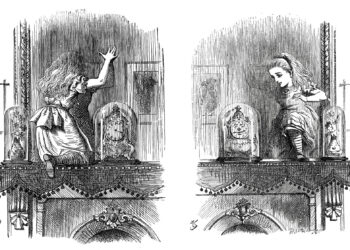Editor’s Note: Today, we revisit a post by Joe Esposito that has bearing on many conversations going on at the margins of the Kitchen. This post was originally published last April.

I will explain what skeuomorphism is in a minute, but first an anecdote.
In the mid-1990s, I was invited to a presentation of the new digital platform of the Chicago Tribune. It was a pretty slick presentation. The content of the print newspaper had been moved to the Web. Articles were linked to one another; you could search across the entire newspaper. The display did not differ markedly from the print publication, though there was greater flexibility, as the digital medium makes possible. And along the top and on the sides were advertisements, looking very much like the kinds of ads you would find in the print edition that was tossed on your doorstep every morning. But these ads did not merely display information about the advertiser; you could click on the ads and be taken to the advertiser’s Web site. All the properties of the print edition plus more: print-plus.
I knew then that the Tribune was doomed. I did not know then, nor do I know now, what the future of newspapers looks like, but certainly it would not look like the print Chicago Tribune, nor was there much chance that the primary business model of newspapers — aggregate an audience and sell that audience to advertisers — would survive the delocalizing properties of the Internet — its most famous instantiation, after all, is called the World Wide Web. The Tribune was doomed not because the people working there were not bright — in fact, they were exceedingly bright and had, like Bob Dylan’s Miss Lonely, gone to the finest schools — but because their imagination of a new thing was based on an old thing. They were trying to fit a square peg into a round hole.
Skeuomorphism, originally a term from archaeology, is type of ornamentation where the design or look of the object helps the user to understand the function of the device or tool. I am myself more interested in the term as a metaphor for something new that has the shape or form of something old. In scholarly communications, the PDF is the supreme skeuomorph — an exact replica of the printed page rendered for computer screens, at least screens large enough to display it (mobile devices need not apply). In e-books we have the skeuomorphism of page numbers. Page numbers make sense for print; they are handy navigational tools. But there are no “pages” in an e-book. Different navigational tools have to be invented, tools that are native to the digital environment. Skeuomorphisms can be helpful. Consider, for example, the image of an old-fashioned bookshelf with bound hardcover books on it, which graces the primary screen of the Apple iBookstore. Viewers recognize that image and know that the books on that virtual shelf represent digital files that can be accessed from any Apple device.
Metaphorically, the management of the Tribune was guilty of first-degree skeuomorphism by thinking that their business model would migrate from print to digital, but most often things are called skeuomorphs when they concern product development. The challenge is a creative one — what are the properties of a new medium and what kind of new products or services can we come up with that seem at home in that new medium, so comfortable that skeuomorphs are not necessary?
Unfortunately, this is not the kind of question that can be designed by a committee. It was, after all, a committee that cooked up the digital edition of the Chicago Tribune. To work in a new medium, you need new minds.
I first heard the term “skeuomorph” applied to the world of publishing, e-books in particular, by Ron Martinez, who is exploring the post-skeuomorphic world at Aerbook, but the case is perhaps well made by two recent outstanding films, which caused me to think about what it would mean to create digital native ebooks. First there is The Artist, which somehow or other managed to win the Academy Award for Best Picture this year. This is a brilliant film, a great work of art. It teaches us about skeuomorphism by working with an unexpected medium, that of the silent movie. The deft handling of the conventions of silent cinema is moving, and even moreso as everyone in the audience knows that the ability to record sound was available to the director. The film is a study of a new medium, a medium that is an imitation of an old medium, and perhaps a sly cultural allegory of the difficulties of a French production team working in an industry dominated by English-language Hollywood. Or perhaps the allegory is political.
The second film is Wim Wenders’ Pina, a tribute to choreographer Pina Bausch. For those unfamiliar with Wenders, please stop reading now and see the marvelous The American Friend or the breathtakingly beautiful Wings of Desire. Pina, on the other hand, is a documentary, but it has one twist: it is 3-D. It is not the first 3-D movie by a long shot, but no other 3-D movie was ever filmed with the quiet authority of Wenders. While there is one early scene in which the dancers walk directly toward the camera, reminding us that the film is indeed in 3-D, most of the time the use of 3-D seems natural. Wenders understands this new medium and renders his work without straining. It is a tour de force. It is difficult for me to imagine any film about dance from here on that will not be in 3-D, paying quiet tribute to Wenders’ mastery.
And that is the problem with getting beyond skeuomorphism in any medium, including publishing. You need a Michel Hazanavicius, the director of The Artist, or a Wim Wenders. All the discipline and training of the Chicago Tribune could not give them that, the truly creative individual who understands the properties of the new digital media on an emotional level. To make something new you have to be someone new.
Those of us working today in scholarly communications are surrounded by skeuomorphs on one side, truly new things on the other. We have the skeuomorph of Green open access, which attempts to take the materials of traditional publishing and bang it into a new form through self-archiving, but then we have the truly innovative PLoS ONE, which has no obvious or immediate forebear. (The flagship journals of the Public Library of Science, on the other hand, are full-blooded skeumorphisms, copying traditional publishing exactly and then adding a dash of open access.) We have scholars who print out articles before reading them, but we also have a growing number of APIs, data-mining services, and Big Data. The world is not one way or the other, at least not yet.
What is missing, though, is an industry-wide commitment to think about new media as new media. Rather than contrast and compare it to print, we could be thinking about digital media’s unique properties. We should not be replacing print collections with digital ones; we should be superseding them.
Discussion
7 Thoughts on "Stick to Your Ribs: Skeuomorphic Publishing — How to Fit a Square Peg Into a Round Hole"
I just wanted to add a couple of comments: As a subscriber to the Chicago Tribune, I read the paper edition every day because the digital version is SO difficult to navigate. Point well taken. Regarding scholarly communications, there are two multimedia journal publishing platforms that have been developed and are in good working order. One is the JSTOR Current Scholarship platform, first developed by the Society of Architectural Historians and University of California Press with funding from the Mellon Foundation. It is one of the first multimedia scholarly journals to illustrate articles with video, sound, panoramic photos, zoomable images and 3D models superimposed over Google Earth maps.
Sample article http://www.jstor.org/stable/10.1525/jsah.2010.69.1.12
The second robust scholarly publishing platform is Scalar. http://scalar.usc.edu/scalar/
The good news is the scholarly world is innovating at a steady pace.
Really good post as always, Joseph. Your point also applies to other aspects of publishing, including educational publishing. The problem extends beyond publishers to the larger ecosystem of the industry, including customers and infrastructure. For instance, my company publishes a native-digital “textbook alternative” for history courses. But helping faculty understand what it does is a challenge, because their main reference point is the old-fashioned print textbook. And then there are college bookstores, which likewise struggle to put our square peg into their round holes. The ones who don’t seem at all flummoxed are the students who use it, which is perhaps no surprise. No doubt all of this will work itself out over time, in all parts of the industry.
If a skeumorph is a “type of ornamentation where the design or look of the object helps the user to understand the function of the device or tool,” I am not quite sure how institutional or subject based repositories (Green OA) fit that description? What ornamentation in IRs are you talking about? The repositories I am familiar with (arXiv, SSRN, a local University IR) do a good job of describing the content that is contained within the source.
Perhaps the problem of today’s skeuomorphs is that they are TODAY’s skeuomorphs (i.e. based on yesterday’s paradigm). What if, instead, we approached the problem one step ahead by attempting to see and present TOMORROW’s skeuomorphs today, with all of the attendant comforts that good skeuomorphs offer, but none of the mental traps of yesterday’s thinking.
I have an alternative to sentences if anyone is interested. It is called an issue tree. It displays the branching links that are already there in what we write but which are hidden in the linear string of writing. The folded linear string of writing is basically clay tablet technology and 6000 years old. It is an efficient use of physical space but virtual space (pan and zoom) is unlimited.
Here is an example of conventional sentence based text and an issue tree of the same content:
http://www.stemed.info/Repo_Tree.pdf
Issue trees facilitate understanding by making visible the hidden structure of expressed thought. This is a structure we struggle to grasp when we read.



